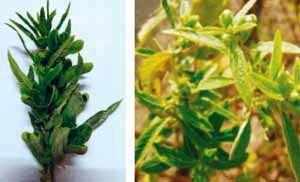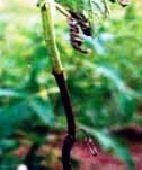Sesame: Diseases and Symptoms
Sesame: Diseases and Symptoms
Phyllody
Disease symptoms All floral parts are transformed into green leafy structures followed by abundant vein clearing in different flower parts.
All floral parts are transformed into green leafy structures followed by abundant vein clearing in different flower parts.- In severe infection, the entire inflorescences is replaced by short twisted leaves closely arranged on a stem with short internodes, abundant abnormal branches bend down.
- Finally, plants look like witches broom.
- If capsules are formed on lower portion of plant they do not yield quality seeds
- The disease is transmitted through jassids and the phytoplasma survives in leaf hopper throughout its life.
Dry root rot
Disease symptoms The fungus attacks young seedling, their stems become water soaked soft and incapable of supporting the seedling which falls over and dies.
The fungus attacks young seedling, their stems become water soaked soft and incapable of supporting the seedling which falls over and dies.- On older seedlings elongated brownish black lesions appear which increase in length and width girdling the stem and plant dies.
Survival and spread - The pathogen survives in seed and soil.
Favourable conditions - High soil temperatures and moisture stress conditions favour the development of the pathogen.
Phytophthora blight
Disease symptomsDisease can occur at all stages of the plant.
- Initial symptom is water soaked spots on leaves and stems.
- The spots are chestnut brown in the beginning later turn to black.
- Premature leaf fall occurs.
- In humid weather, severity of disease increases, main root is affected, diseased plants are easily pulled out and produce shriveled seeds and gives blighted appearance.
- The pathogen survives in soil
- High soil moisture favours the development of the pathogen.
- The disease is severe in the area of heavy soil with high rainfall
Alternaria blight
Disease symptoms:- The pathogen attacks all parts of the plant at all stages.
- Small, dark brown water soaked, round to irregular lesions, with concentric rings, 1-8 mm in diameter appear on the leaves and under excessive atmospheric and soil humidity the spot increases in size and number.
- The lesions may also appear on the midrib and veins of the leaves.
- Milder attacks cause only defoliation, in severe cases the plant may die.
- The pathogen is seed borne.
- Temperature of 20-30o C and high humid conditions favour the disease.
IPM for Sesame
To know the IPM practices for Sesame, click here.
Source: NIPHM and Directorate of Plant Protection, Quarantine & Storage
Last Modified : 10/16/2020
© C–DAC.All content appearing on the vikaspedia portal is through collaborative effort of vikaspedia and its partners.We encourage you to use and share the content in a respectful and fair manner. Please leave all source links intact and adhere to applicable copyright and intellectual property guidelines and laws.
RELATED ITEMS
Castor: Diseases and Symptoms
This topic covers the Information related to Disea...
Cumin: Diseases and Symptoms
This topic covers the Information related to Disea...
Grapes: Diseases and Symptoms
This topic covers the Information related to Disea...
Mustard: Diseases and Symptoms
This topic covers the Information related to Disea...
